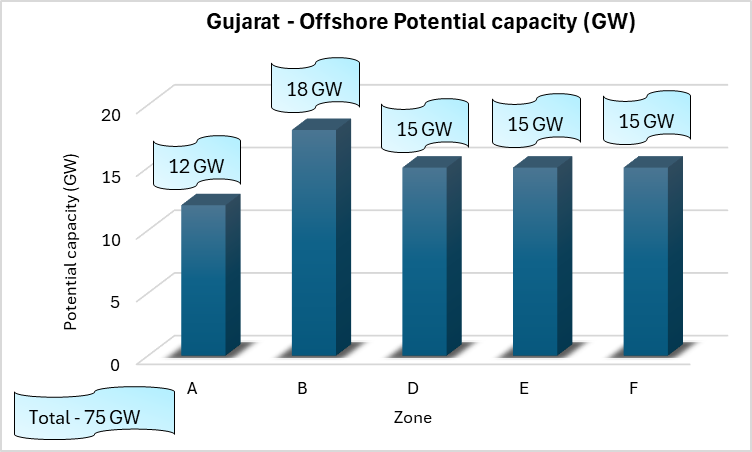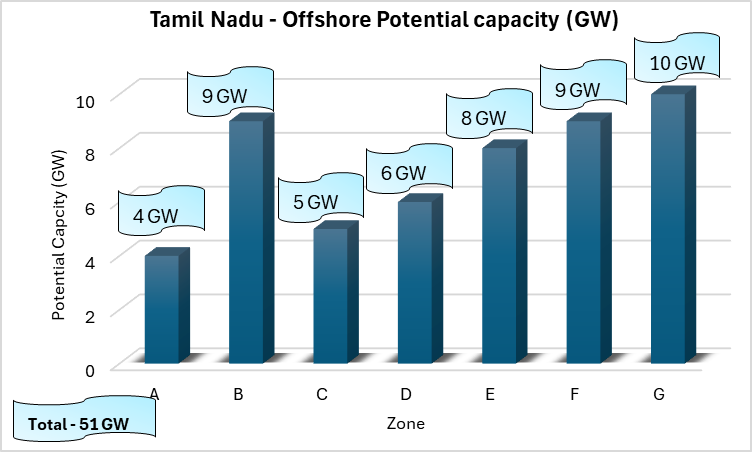July 11 , 2024
India to enter the global momentum in offshore wind energy projects
India's offshore wind energy initiative includes a
substantial ₹7453 crore investment to develop 1 gigawatt of
offshore wind capacity by 2025
Offshore wind farms can operate at a Capacity Utilization
Factor (CUF) of 40-50%, much higher than many onshore wind
farms, making them more efficient and reliable.
Here’s a detailed account of how India is advancing its offshore
wind energy initiatives:
Offshore Wind Farms:
Offshore wind energy technology involves deploying wind turbines in ocean or sea environments to harness wind power. Advanced turbines, mounted on fixed or floating platforms, convert kinetic wind energy into electrical power. Fixed-bottom structures are suitable for shallow waters up to 60 meters, while floating platforms, anchored to the seabed, extend operational depth beyond 60 meters. Offshore wind farms support large-scale renewable energy generation and contribute to global decarbonization goals.
Advantages of offshore wind farms: Offshore wind farms offer higher and more consistent wind speeds which increase the capacity utilization factor (CUF). These conditions allow for more reliable and efficient energy generation compared to onshore setups. Offshore turbines can operate at a CUF of 40-50%, significantly higher than many onshore wind farms. Additionally, offshore wind farms minimize land-use conflicts, reduce visual and noise impacts, and provide scalable energy solutions that can be integrated into national grids without extensive land acquisition making them an attractive alternative for densely populated or ecologically sensitive areas.
India's Venture into Offshore Wind Energy:
Policy Framework: The National Offshore Wind Energy Policy-2015 established the groundwork for offshore wind power in India. The policy delineates the roles of the Ministry of New and Renewable Energy (MNRE) and the National Institute of Wind Energy (NIWE) in fostering offshore wind development up to 200 nautical miles from the coastline, within the Exclusive Economic Zone (EEZ).
Potential zones and Studies:
Identification of Zones: : Initial assessments by NIWE, with FOWIND as a knowledge partner, identified potential zones off the southern and western coasts of India, particularly off Gujarat and Tamil Nadu, for offshore wind farm development. Eight zones each have been identified off these coasts for potential development.
India's offshore wind projects off the coasts of Gujarat and Tamil Nadu are expected to reduce CO2 emissions by 2.98 million tons annually over 25 years.


(Numerical data source: NTPC)
Technical Assessments: Detailed studies include wind resource assessment, bathymetry, and environmental impact considerations. LiDAR technology has been deployed in certain zones to measure wind speed and dynamics accurately.
Development Models:
Model-A (VGF Model): Focuses on zones where comprehensive studies have been conducted. This model offers Viability Gap Funding (VGF) to bridge the cost discrepancies, facilitating competitive power tariffs.
Recent news update:
Union cabinet to approve funding scheme for 1 GW for offshore wind projects off coasts of Gujarat and Tamil Nadu:
-
The Union Finance Minister, Nirmala Sitharaman, has announced a Viability Gap Funding (VGF) of ₹7,453 crore for the fiscal year 2024-25, aimed at developing a 1 gigawatt offshore wind capacity
-
The allocation includes ₹6,853 crore for the wind energy projects themselves and an additional ₹600 crore for upgrading two strategic ports to bolster project logistics.
Geographical Focus:
-
The initiative targets the coasts of Gujarat and Tamil Nadu for the installation of 500 megawatts each, leveraging their wind potential to maximize output.
Strategic and Economic Benefits:
-
This policy aligns with the National Offshore Wind Energy Policy of 2015 and is expected to enhance India's renewable energy infrastructure significantly, reduce CO2 emissions by 2.98 million tons annually over 25 years, and contribute to the national target of a net-zero emission status by 2070.
-
A projected investment of ₹4,50,000 crore is anticipated for the development of 37 gigawatts of offshore wind energy, part of India’s broader goal to achieve 500 gigawatts of renewable capacity by 2030.
Operational and Environmental Impact:
-
The successful implementation of these projects is expected to generate approximately 3.72 billion units of renewable electricity annually, creating substantial employment opportunities and fostering indigenous manufacturing capabilities.
Overall, the scheme is intended to kick-start offshore wind energy development in India and build the necessary ecosystem to support the sector's growth, aligning with the country's renewable energy targets and economic development strategies.
Model-B (Non-VGF with Exclusivity): Allows developers to lease areas for fixed periods, promoting investments by offering exclusivity during the survey and study phase. This model operates without central financial support but includes other incentives like waivers on transmission charges and potential carbon credit benefits.
Model-C (Non-VGF without Exclusivity): Open for developers to propose new sites within the EEZ, encouraging broader participation and innovative site exploration without central subsidies.
Supportive Measures:
Connectivity and Regulatory Support:
-
The government assures support through streamlined regulatory processes, including a single-window clearance mechanism to simplify approvals.
-
NIWE serves as a single-window for coordinating clearances for studies and project initiation, promoting a streamlined process.
-
Bidding processes and lease agreements are standardized, with specific fees and terms outlined for various stages of project development.
-
Responsibilities for power evacuation up to the offshore sub-station lie with the developer.
-
Clearances and operational guidelines for project development are extensively detailed, ensuring developers are aware of all regulatory requirements.
Financial Incentives: Projects are expected to have financial incentives like VGF, and provisions for power evacuation infrastructure.
Besides VGF, other fiscal incentives such as import duties exemptions, low-cost finance options, and potentially dedicated green zones at ports bolster the sector’s growth.
Detailed auction trajectories from 2023-2030 show expected capacities under each model with specific timelines.
Future Outlook:
Expansion Plans: India targets achieving 30 GW of offshore wind capacity by 2030, reflecting its commitment to enhancing renewable energy capacity and reducing carbon emissions.
Challenges: Addressing high initial costs, ensuring robust grid infrastructure, and mitigating environmental impacts are crucial for the sustainable growth of offshore wind energy in India.
India's strategic push into offshore wind energy, underpinned by substantial Viability Gap Funding and robust policy frameworks, positions it as a future leader in renewable energy on the global stage. India not only aims to meet its escalating energy demands sustainably but also to significantly cut carbon emissions, fostering economic growth and technological innovation in the green energy sector. This elevates offshore wind energy as a crucial element for India, aiming to enhance the renewable energy framework and achieve ambitious net zero target emissions by 2070.

